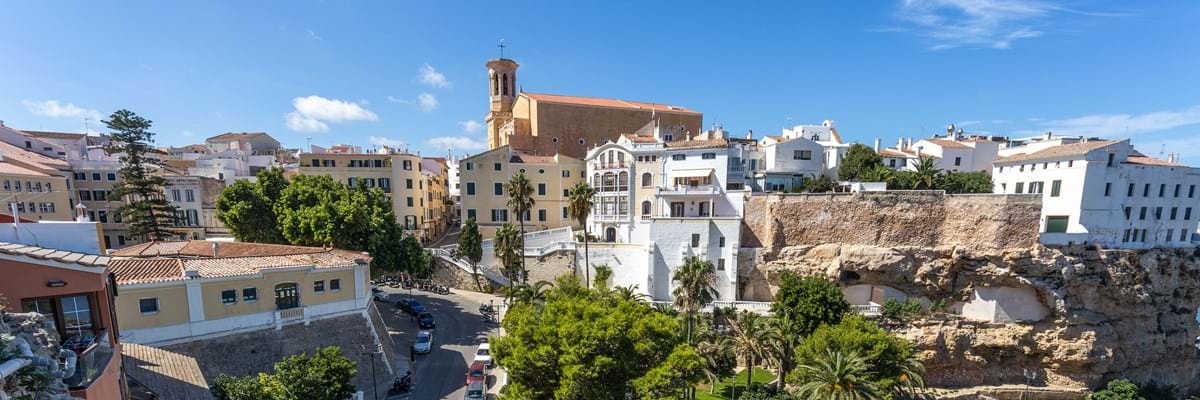They are only 23 miles apart, at opposite ends of the island. And these opposites attract! They share some lovely attractions – but they are also so wonderfully different.
The lovely port of Ciutadella, on the western end, was the capital of Menorca until the British took over in the 18th century. The deep water of the natural harbour of Mahon, at the eastern end, was hugely attractive to the Royal Navy. So they built a dockyard and a fort, installed a governor - and Mahon became the new capital.
Both cities are charming, have beautiful harbours, a huge variety of shops, cafes, restaurants and bars, and are rich in history. But they each have their own unique atmospheres.

Ciutadella
Ciutadella gets its name from “citadel” or fortified city because that’s what it once was. It’s said that Ciutadella is a 16th century Spanish city frozen in time.
As the city expanded some of the old walls came down, but not all of them. The old and very pretty harbour is tucked under the walls of the old city and lined with boats, restaurants and bars. It’s where the boats leave for their round-the-island tours or nearby beaches.
The charming old town has arcades and courtyards with shops and cafes and a beautiful 14th century cathedral. The main town square, Plaça des Born, is the city’s beautiful centerpiece. It’s lined with elegant buildings including the city hall that was once a royal palace.
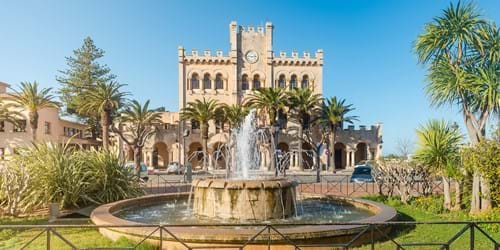
There’s a market in the square on Friday and Saturday mornings and a craft market every evening near the port in the summer months. Evenings are the best time to shop, eat and soak up the atmosphere. There are clubs and music bars in the harbour area that start to take off around midnight.
Ciutadella celebrates its patron saint’s day, Sant Joan, on the 23rd and 24th of June with a traditional fiesta that includes parades of more than 100 Menorcan horses and riders in fancy dress, live music, dancing and feasts!
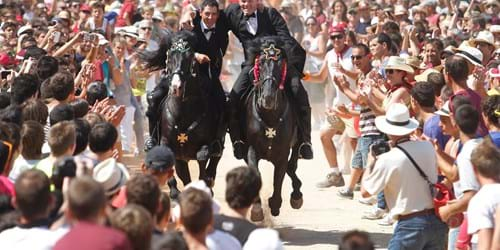
Mahon
Mahon is the Spanish version of the Catalan town name of Maó and the name may be the reason why mayonnaise is called what it is. More on that later.
Much of the busy harbour is devoted to luxury motorboats, sailing yachts, fishing boats and a water taxi. Tourists can stroll the length of the harbour, maybe stop at one of the many cafes, or climb aboard one of the excursion boats that set off every day to explore Menorca’s harbour. Live music and artisan markets are often held there in the evenings during the summer months.
Pavement cafes and bars as well as a wide variety of shops and restaurants are tucked away in a maze of narrow city centre streets. There’s an intriguing mix of architectural styles which includes very English 18th century Georgian buildings with stylish balconies and bow windows. Look out for the un-Spanish sash windows! There is also a gin distillery which dates back to the British occupation. During the fiestas, Menorcans drink their gin with a lemon drink (often Kas Limon) and call it Pomada.
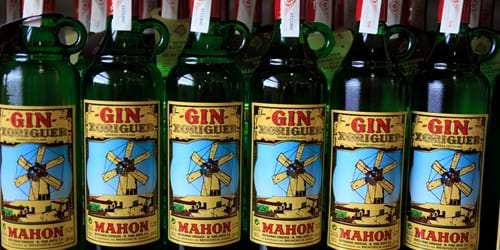
There are museums, a cathedral, churches, an opera house, markets and a casino. It was, supposedly, once the lair of the notorious pirate Barbarossa who attacked Mahon in 1535 and took 6,000 prisoners. He was one of many invaders, including the Carthaginians, Romans and Vikings.
The British gained possession in 1708 and kept on losing and regaining the island for almost a century before finally withdrawing and leaving it to the Spanish. The dockyard they built in Mahon is now a Spanish Naval Station.
There are old British garrison buildings on an islet and a former military hospital, recently restored, on another. With the arrival of the British, work began on a new fortress, which can be visited today.
An additional seven-sided fort was built in the 1720s and is also an intriguing tourist attraction. Fort Marlborough, named after Lord Marlborough, overlooks the southern entrance to the harbour. It was built to open fire on invading ships but now it’s a museum that features the tumultuous history of Menorca and Europe during the 18th century. One of the attractions is a recreation of the siege of 1782 when the fort was badly damaged by the Spanish.
What about the mayo? The British were driven out of Mahon for a short while by the French in 1756 and the great mayonnaise debate goes back to then. It is claimed that the victorious French commander, the Duke of Richelieu, was served the local dressing at his celebratory meal. When he eventually returned to France he had “mahonaise” introduced to the French Court – and is the rest history?
Not quite. A number of other claims suggest the dressing was French all along. But some say that a simple mixture of egg yolk and olive oil was probably commonplace in many Mediterranean countries long before the Duke of Richelieu tasted it.
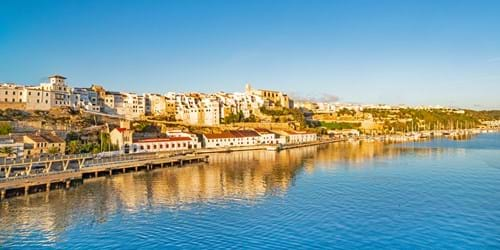
A three-day summer festival involving street parties, music and horses is held in Mahon from September 7 to 9 every year. The stars of these Fiestas de La Mare de Déu de Gràcia are the Menorcan horses that parade, race and perform horsemanship tricks including the jaleo when they balance on their back legs. The fiesta ends with a fireworks display.



